International Marketing Strategies
VerifiedAdded on 2020/01/28
|9
|3150
|40
Literature Review
AI Summary
This assignment delves into the realm of international marketing. It requires you to critically evaluate various marketing strategies employed by companies operating in a global landscape. You'll need to identify key challenges and opportunities associated with international marketing, explore influential global trends shaping the industry, and ultimately propose effective strategies for success in the global market.
Contribute Materials
Your contribution can guide someone’s learning journey. Share your
documents today.
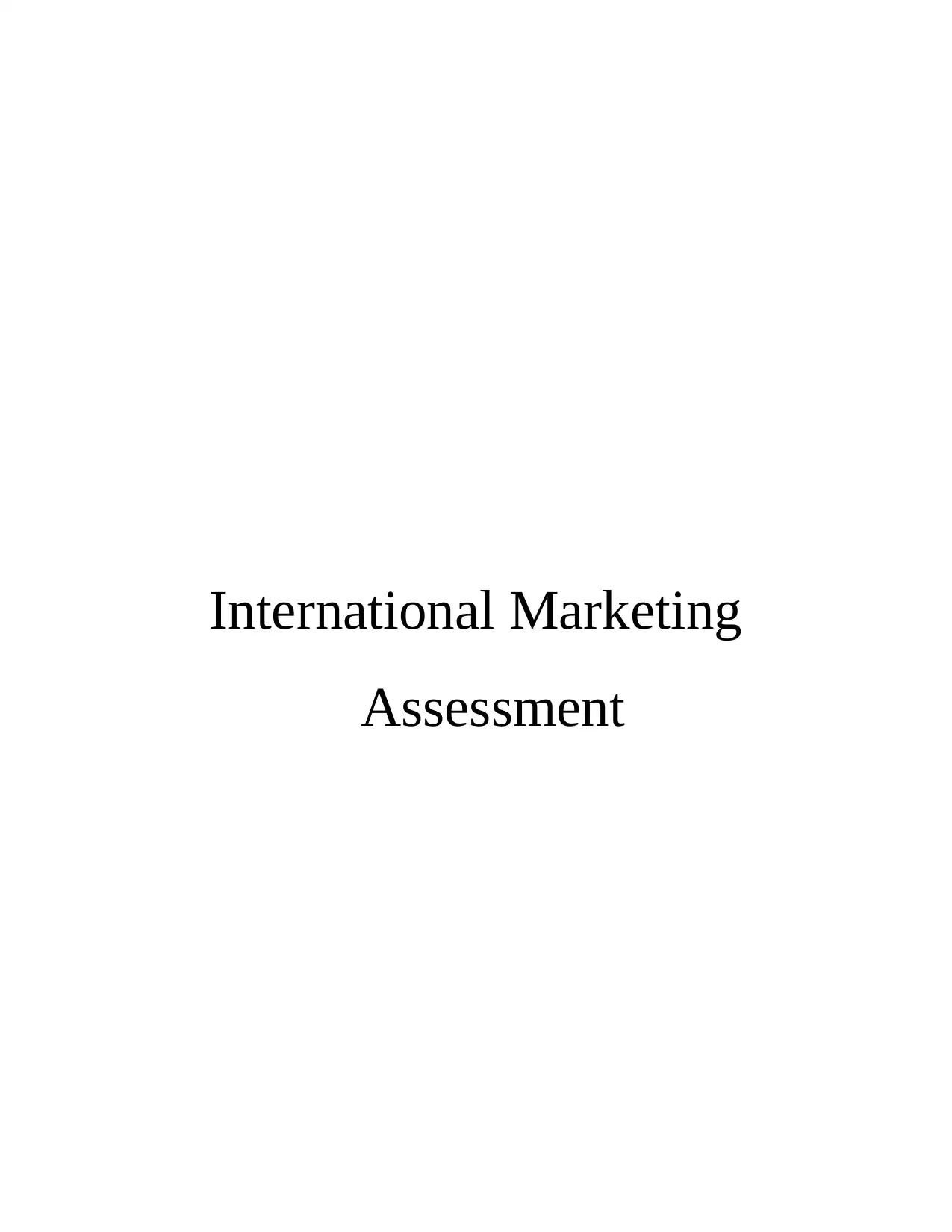
International Marketing
Assessment
Assessment
Secure Best Marks with AI Grader
Need help grading? Try our AI Grader for instant feedback on your assignments.
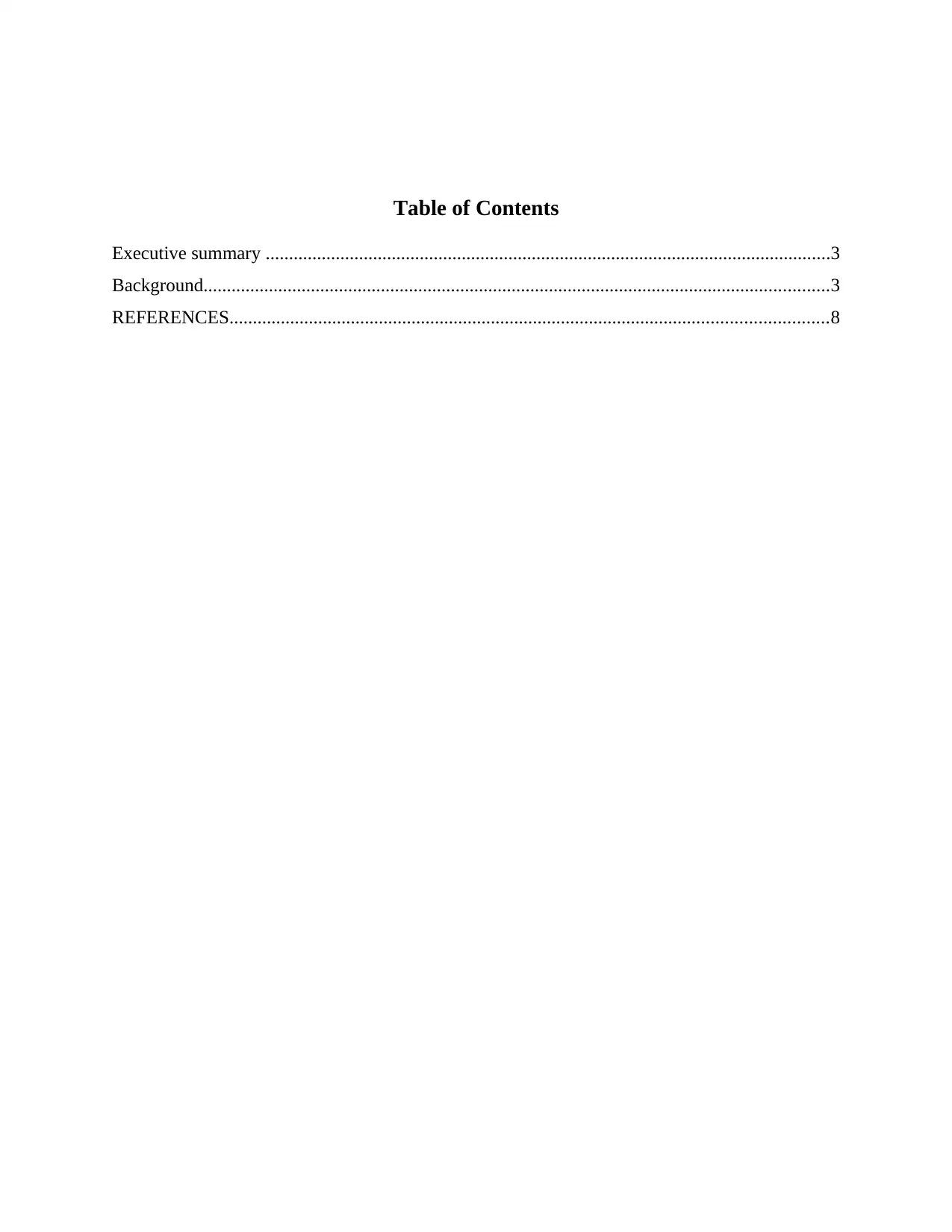
Table of Contents
Executive summary .........................................................................................................................3
Background......................................................................................................................................3
REFERENCES................................................................................................................................8
Executive summary .........................................................................................................................3
Background......................................................................................................................................3
REFERENCES................................................................................................................................8
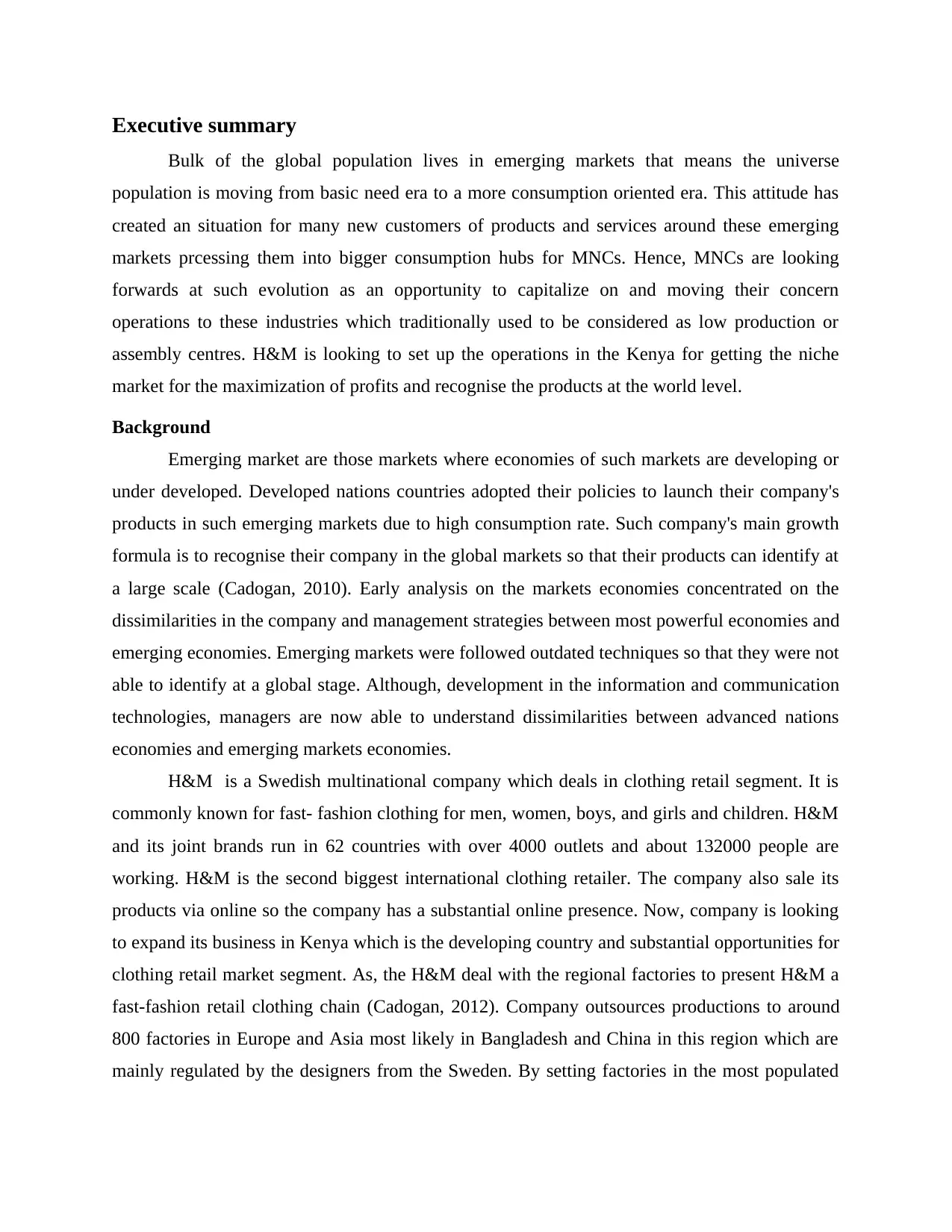
Executive summary
Bulk of the global population lives in emerging markets that means the universe
population is moving from basic need era to a more consumption oriented era. This attitude has
created an situation for many new customers of products and services around these emerging
markets prcessing them into bigger consumption hubs for MNCs. Hence, MNCs are looking
forwards at such evolution as an opportunity to capitalize on and moving their concern
operations to these industries which traditionally used to be considered as low production or
assembly centres. H&M is looking to set up the operations in the Kenya for getting the niche
market for the maximization of profits and recognise the products at the world level.
Background
Emerging market are those markets where economies of such markets are developing or
under developed. Developed nations countries adopted their policies to launch their company's
products in such emerging markets due to high consumption rate. Such company's main growth
formula is to recognise their company in the global markets so that their products can identify at
a large scale (Cadogan, 2010). Early analysis on the markets economies concentrated on the
dissimilarities in the company and management strategies between most powerful economies and
emerging economies. Emerging markets were followed outdated techniques so that they were not
able to identify at a global stage. Although, development in the information and communication
technologies, managers are now able to understand dissimilarities between advanced nations
economies and emerging markets economies.
H&M is a Swedish multinational company which deals in clothing retail segment. It is
commonly known for fast- fashion clothing for men, women, boys, and girls and children. H&M
and its joint brands run in 62 countries with over 4000 outlets and about 132000 people are
working. H&M is the second biggest international clothing retailer. The company also sale its
products via online so the company has a substantial online presence. Now, company is looking
to expand its business in Kenya which is the developing country and substantial opportunities for
clothing retail market segment. As, the H&M deal with the regional factories to present H&M a
fast-fashion retail clothing chain (Cadogan, 2012). Company outsources productions to around
800 factories in Europe and Asia most likely in Bangladesh and China in this region which are
mainly regulated by the designers from the Sweden. By setting factories in the most populated
Bulk of the global population lives in emerging markets that means the universe
population is moving from basic need era to a more consumption oriented era. This attitude has
created an situation for many new customers of products and services around these emerging
markets prcessing them into bigger consumption hubs for MNCs. Hence, MNCs are looking
forwards at such evolution as an opportunity to capitalize on and moving their concern
operations to these industries which traditionally used to be considered as low production or
assembly centres. H&M is looking to set up the operations in the Kenya for getting the niche
market for the maximization of profits and recognise the products at the world level.
Background
Emerging market are those markets where economies of such markets are developing or
under developed. Developed nations countries adopted their policies to launch their company's
products in such emerging markets due to high consumption rate. Such company's main growth
formula is to recognise their company in the global markets so that their products can identify at
a large scale (Cadogan, 2010). Early analysis on the markets economies concentrated on the
dissimilarities in the company and management strategies between most powerful economies and
emerging economies. Emerging markets were followed outdated techniques so that they were not
able to identify at a global stage. Although, development in the information and communication
technologies, managers are now able to understand dissimilarities between advanced nations
economies and emerging markets economies.
H&M is a Swedish multinational company which deals in clothing retail segment. It is
commonly known for fast- fashion clothing for men, women, boys, and girls and children. H&M
and its joint brands run in 62 countries with over 4000 outlets and about 132000 people are
working. H&M is the second biggest international clothing retailer. The company also sale its
products via online so the company has a substantial online presence. Now, company is looking
to expand its business in Kenya which is the developing country and substantial opportunities for
clothing retail market segment. As, the H&M deal with the regional factories to present H&M a
fast-fashion retail clothing chain (Cadogan, 2012). Company outsources productions to around
800 factories in Europe and Asia most likely in Bangladesh and China in this region which are
mainly regulated by the designers from the Sweden. By setting factories in the most populated
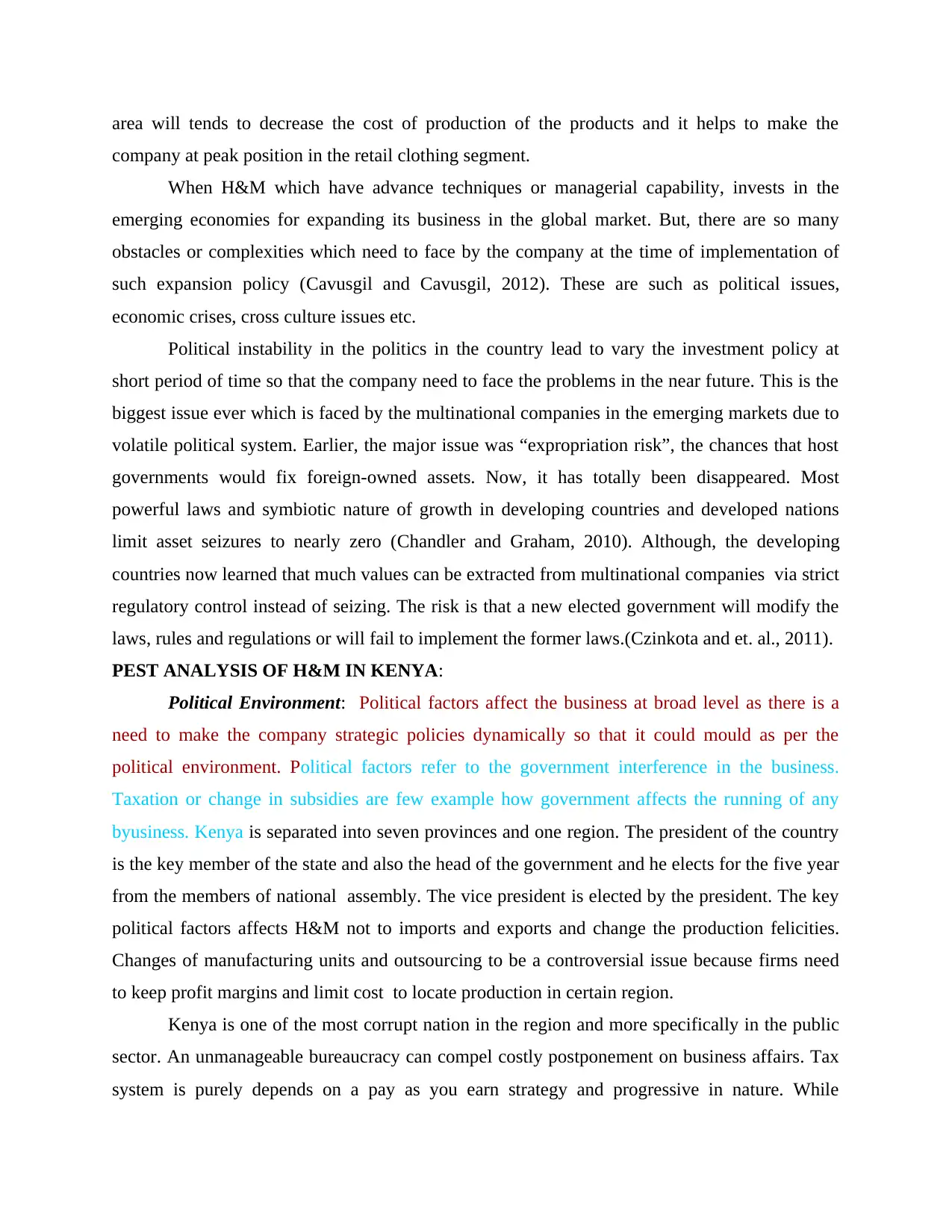
area will tends to decrease the cost of production of the products and it helps to make the
company at peak position in the retail clothing segment.
When H&M which have advance techniques or managerial capability, invests in the
emerging economies for expanding its business in the global market. But, there are so many
obstacles or complexities which need to face by the company at the time of implementation of
such expansion policy (Cavusgil and Cavusgil, 2012). These are such as political issues,
economic crises, cross culture issues etc.
Political instability in the politics in the country lead to vary the investment policy at
short period of time so that the company need to face the problems in the near future. This is the
biggest issue ever which is faced by the multinational companies in the emerging markets due to
volatile political system. Earlier, the major issue was “expropriation risk”, the chances that host
governments would fix foreign-owned assets. Now, it has totally been disappeared. Most
powerful laws and symbiotic nature of growth in developing countries and developed nations
limit asset seizures to nearly zero (Chandler and Graham, 2010). Although, the developing
countries now learned that much values can be extracted from multinational companies via strict
regulatory control instead of seizing. The risk is that a new elected government will modify the
laws, rules and regulations or will fail to implement the former laws.(Czinkota and et. al., 2011).
PEST ANALYSIS OF H&M IN KENYA:
Political Environment: Political factors affect the business at broad level as there is a
need to make the company strategic policies dynamically so that it could mould as per the
political environment. Political factors refer to the government interference in the business.
Taxation or change in subsidies are few example how government affects the running of any
byusiness. Kenya is separated into seven provinces and one region. The president of the country
is the key member of the state and also the head of the government and he elects for the five year
from the members of national assembly. The vice president is elected by the president. The key
political factors affects H&M not to imports and exports and change the production felicities.
Changes of manufacturing units and outsourcing to be a controversial issue because firms need
to keep profit margins and limit cost to locate production in certain region.
Kenya is one of the most corrupt nation in the region and more specifically in the public
sector. An unmanageable bureaucracy can compel costly postponement on business affairs. Tax
system is purely depends on a pay as you earn strategy and progressive in nature. While
company at peak position in the retail clothing segment.
When H&M which have advance techniques or managerial capability, invests in the
emerging economies for expanding its business in the global market. But, there are so many
obstacles or complexities which need to face by the company at the time of implementation of
such expansion policy (Cavusgil and Cavusgil, 2012). These are such as political issues,
economic crises, cross culture issues etc.
Political instability in the politics in the country lead to vary the investment policy at
short period of time so that the company need to face the problems in the near future. This is the
biggest issue ever which is faced by the multinational companies in the emerging markets due to
volatile political system. Earlier, the major issue was “expropriation risk”, the chances that host
governments would fix foreign-owned assets. Now, it has totally been disappeared. Most
powerful laws and symbiotic nature of growth in developing countries and developed nations
limit asset seizures to nearly zero (Chandler and Graham, 2010). Although, the developing
countries now learned that much values can be extracted from multinational companies via strict
regulatory control instead of seizing. The risk is that a new elected government will modify the
laws, rules and regulations or will fail to implement the former laws.(Czinkota and et. al., 2011).
PEST ANALYSIS OF H&M IN KENYA:
Political Environment: Political factors affect the business at broad level as there is a
need to make the company strategic policies dynamically so that it could mould as per the
political environment. Political factors refer to the government interference in the business.
Taxation or change in subsidies are few example how government affects the running of any
byusiness. Kenya is separated into seven provinces and one region. The president of the country
is the key member of the state and also the head of the government and he elects for the five year
from the members of national assembly. The vice president is elected by the president. The key
political factors affects H&M not to imports and exports and change the production felicities.
Changes of manufacturing units and outsourcing to be a controversial issue because firms need
to keep profit margins and limit cost to locate production in certain region.
Kenya is one of the most corrupt nation in the region and more specifically in the public
sector. An unmanageable bureaucracy can compel costly postponement on business affairs. Tax
system is purely depends on a pay as you earn strategy and progressive in nature. While
Secure Best Marks with AI Grader
Need help grading? Try our AI Grader for instant feedback on your assignments.
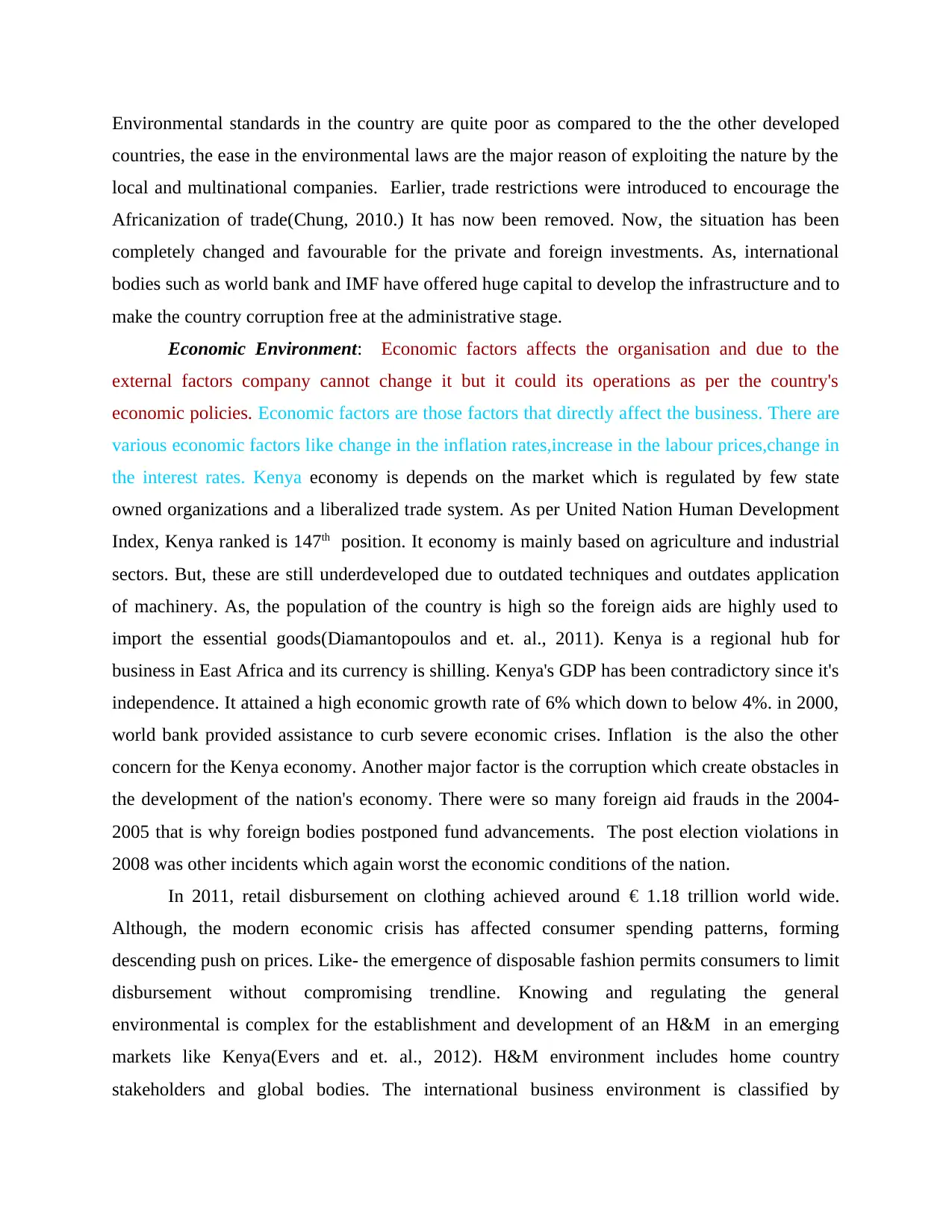
Environmental standards in the country are quite poor as compared to the the other developed
countries, the ease in the environmental laws are the major reason of exploiting the nature by the
local and multinational companies. Earlier, trade restrictions were introduced to encourage the
Africanization of trade(Chung, 2010.) It has now been removed. Now, the situation has been
completely changed and favourable for the private and foreign investments. As, international
bodies such as world bank and IMF have offered huge capital to develop the infrastructure and to
make the country corruption free at the administrative stage.
Economic Environment: Economic factors affects the organisation and due to the
external factors company cannot change it but it could its operations as per the country's
economic policies. Economic factors are those factors that directly affect the business. There are
various economic factors like change in the inflation rates,increase in the labour prices,change in
the interest rates. Kenya economy is depends on the market which is regulated by few state
owned organizations and a liberalized trade system. As per United Nation Human Development
Index, Kenya ranked is 147th position. It economy is mainly based on agriculture and industrial
sectors. But, these are still underdeveloped due to outdated techniques and outdates application
of machinery. As, the population of the country is high so the foreign aids are highly used to
import the essential goods(Diamantopoulos and et. al., 2011). Kenya is a regional hub for
business in East Africa and its currency is shilling. Kenya's GDP has been contradictory since it's
independence. It attained a high economic growth rate of 6% which down to below 4%. in 2000,
world bank provided assistance to curb severe economic crises. Inflation is the also the other
concern for the Kenya economy. Another major factor is the corruption which create obstacles in
the development of the nation's economy. There were so many foreign aid frauds in the 2004-
2005 that is why foreign bodies postponed fund advancements. The post election violations in
2008 was other incidents which again worst the economic conditions of the nation.
In 2011, retail disbursement on clothing achieved around € 1.18 trillion world wide.
Although, the modern economic crisis has affected consumer spending patterns, forming
descending push on prices. Like- the emergence of disposable fashion permits consumers to limit
disbursement without compromising trendline. Knowing and regulating the general
environmental is complex for the establishment and development of an H&M in an emerging
markets like Kenya(Evers and et. al., 2012). H&M environment includes home country
stakeholders and global bodies. The international business environment is classified by
countries, the ease in the environmental laws are the major reason of exploiting the nature by the
local and multinational companies. Earlier, trade restrictions were introduced to encourage the
Africanization of trade(Chung, 2010.) It has now been removed. Now, the situation has been
completely changed and favourable for the private and foreign investments. As, international
bodies such as world bank and IMF have offered huge capital to develop the infrastructure and to
make the country corruption free at the administrative stage.
Economic Environment: Economic factors affects the organisation and due to the
external factors company cannot change it but it could its operations as per the country's
economic policies. Economic factors are those factors that directly affect the business. There are
various economic factors like change in the inflation rates,increase in the labour prices,change in
the interest rates. Kenya economy is depends on the market which is regulated by few state
owned organizations and a liberalized trade system. As per United Nation Human Development
Index, Kenya ranked is 147th position. It economy is mainly based on agriculture and industrial
sectors. But, these are still underdeveloped due to outdated techniques and outdates application
of machinery. As, the population of the country is high so the foreign aids are highly used to
import the essential goods(Diamantopoulos and et. al., 2011). Kenya is a regional hub for
business in East Africa and its currency is shilling. Kenya's GDP has been contradictory since it's
independence. It attained a high economic growth rate of 6% which down to below 4%. in 2000,
world bank provided assistance to curb severe economic crises. Inflation is the also the other
concern for the Kenya economy. Another major factor is the corruption which create obstacles in
the development of the nation's economy. There were so many foreign aid frauds in the 2004-
2005 that is why foreign bodies postponed fund advancements. The post election violations in
2008 was other incidents which again worst the economic conditions of the nation.
In 2011, retail disbursement on clothing achieved around € 1.18 trillion world wide.
Although, the modern economic crisis has affected consumer spending patterns, forming
descending push on prices. Like- the emergence of disposable fashion permits consumers to limit
disbursement without compromising trendline. Knowing and regulating the general
environmental is complex for the establishment and development of an H&M in an emerging
markets like Kenya(Evers and et. al., 2012). H&M environment includes home country
stakeholders and global bodies. The international business environment is classified by
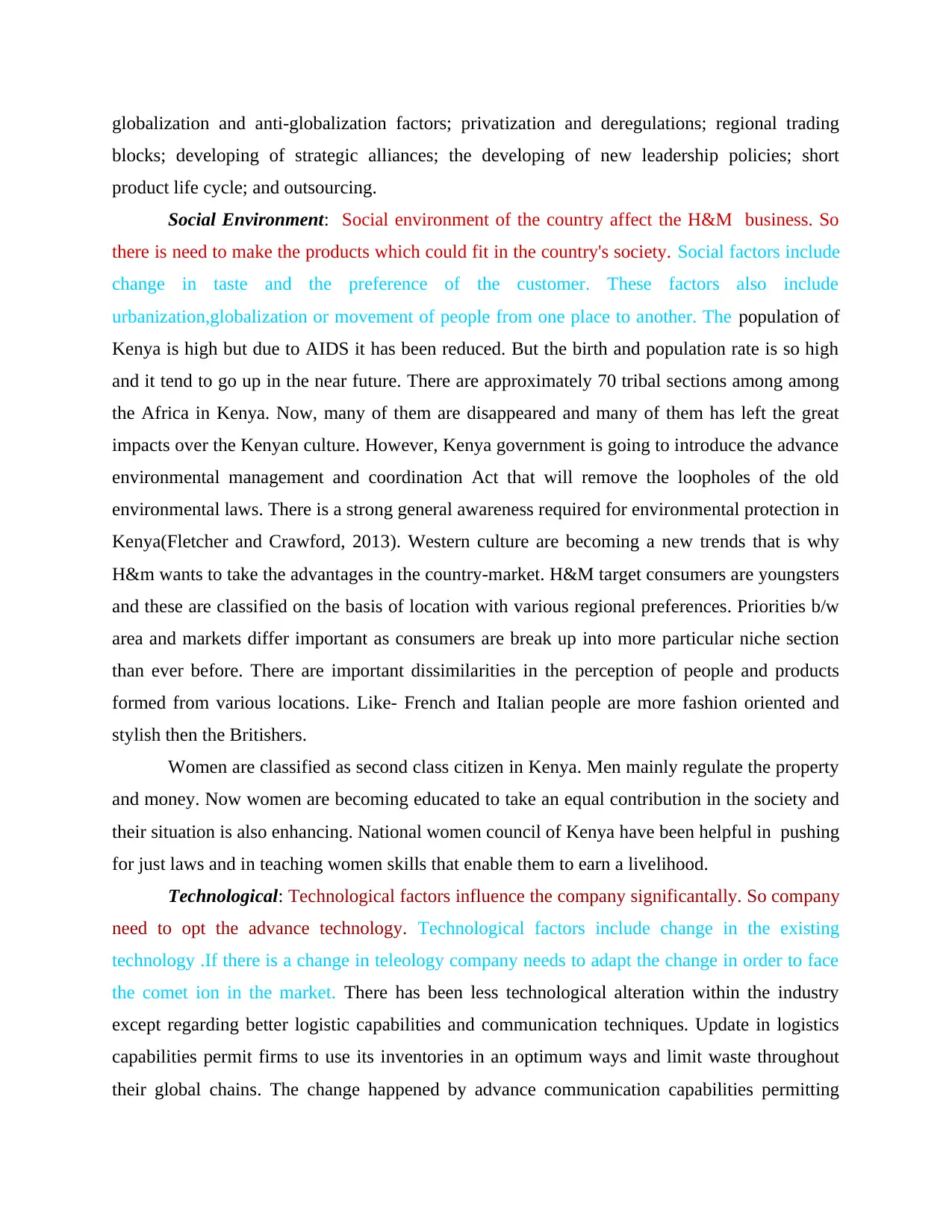
globalization and anti-globalization factors; privatization and deregulations; regional trading
blocks; developing of strategic alliances; the developing of new leadership policies; short
product life cycle; and outsourcing.
Social Environment: Social environment of the country affect the H&M business. So
there is need to make the products which could fit in the country's society. Social factors include
change in taste and the preference of the customer. These factors also include
urbanization,globalization or movement of people from one place to another. The population of
Kenya is high but due to AIDS it has been reduced. But the birth and population rate is so high
and it tend to go up in the near future. There are approximately 70 tribal sections among among
the Africa in Kenya. Now, many of them are disappeared and many of them has left the great
impacts over the Kenyan culture. However, Kenya government is going to introduce the advance
environmental management and coordination Act that will remove the loopholes of the old
environmental laws. There is a strong general awareness required for environmental protection in
Kenya(Fletcher and Crawford, 2013). Western culture are becoming a new trends that is why
H&m wants to take the advantages in the country-market. H&M target consumers are youngsters
and these are classified on the basis of location with various regional preferences. Priorities b/w
area and markets differ important as consumers are break up into more particular niche section
than ever before. There are important dissimilarities in the perception of people and products
formed from various locations. Like- French and Italian people are more fashion oriented and
stylish then the Britishers.
Women are classified as second class citizen in Kenya. Men mainly regulate the property
and money. Now women are becoming educated to take an equal contribution in the society and
their situation is also enhancing. National women council of Kenya have been helpful in pushing
for just laws and in teaching women skills that enable them to earn a livelihood.
Technological: Technological factors influence the company significantally. So company
need to opt the advance technology. Technological factors include change in the existing
technology .If there is a change in teleology company needs to adapt the change in order to face
the comet ion in the market. There has been less technological alteration within the industry
except regarding better logistic capabilities and communication techniques. Update in logistics
capabilities permit firms to use its inventories in an optimum ways and limit waste throughout
their global chains. The change happened by advance communication capabilities permitting
blocks; developing of strategic alliances; the developing of new leadership policies; short
product life cycle; and outsourcing.
Social Environment: Social environment of the country affect the H&M business. So
there is need to make the products which could fit in the country's society. Social factors include
change in taste and the preference of the customer. These factors also include
urbanization,globalization or movement of people from one place to another. The population of
Kenya is high but due to AIDS it has been reduced. But the birth and population rate is so high
and it tend to go up in the near future. There are approximately 70 tribal sections among among
the Africa in Kenya. Now, many of them are disappeared and many of them has left the great
impacts over the Kenyan culture. However, Kenya government is going to introduce the advance
environmental management and coordination Act that will remove the loopholes of the old
environmental laws. There is a strong general awareness required for environmental protection in
Kenya(Fletcher and Crawford, 2013). Western culture are becoming a new trends that is why
H&m wants to take the advantages in the country-market. H&M target consumers are youngsters
and these are classified on the basis of location with various regional preferences. Priorities b/w
area and markets differ important as consumers are break up into more particular niche section
than ever before. There are important dissimilarities in the perception of people and products
formed from various locations. Like- French and Italian people are more fashion oriented and
stylish then the Britishers.
Women are classified as second class citizen in Kenya. Men mainly regulate the property
and money. Now women are becoming educated to take an equal contribution in the society and
their situation is also enhancing. National women council of Kenya have been helpful in pushing
for just laws and in teaching women skills that enable them to earn a livelihood.
Technological: Technological factors influence the company significantally. So company
need to opt the advance technology. Technological factors include change in the existing
technology .If there is a change in teleology company needs to adapt the change in order to face
the comet ion in the market. There has been less technological alteration within the industry
except regarding better logistic capabilities and communication techniques. Update in logistics
capabilities permit firms to use its inventories in an optimum ways and limit waste throughout
their global chains. The change happened by advance communication capabilities permitting
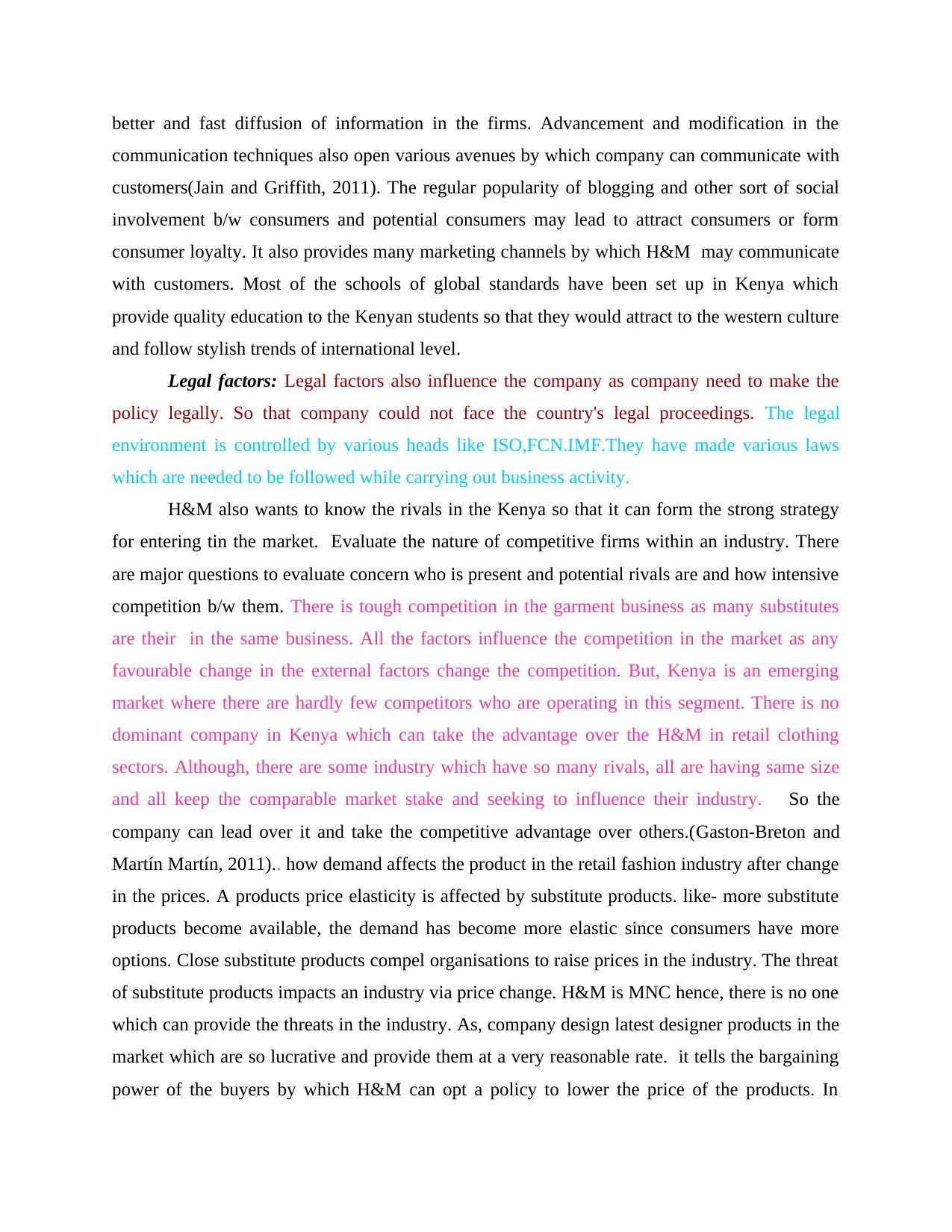
better and fast diffusion of information in the firms. Advancement and modification in the
communication techniques also open various avenues by which company can communicate with
customers(Jain and Griffith, 2011). The regular popularity of blogging and other sort of social
involvement b/w consumers and potential consumers may lead to attract consumers or form
consumer loyalty. It also provides many marketing channels by which H&M may communicate
with customers. Most of the schools of global standards have been set up in Kenya which
provide quality education to the Kenyan students so that they would attract to the western culture
and follow stylish trends of international level.
Legal factors: Legal factors also influence the company as company need to make the
policy legally. So that company could not face the country's legal proceedings. The legal
environment is controlled by various heads like ISO,FCN.IMF.They have made various laws
which are needed to be followed while carrying out business activity.
H&M also wants to know the rivals in the Kenya so that it can form the strong strategy
for entering tin the market. Evaluate the nature of competitive firms within an industry. There
are major questions to evaluate concern who is present and potential rivals are and how intensive
competition b/w them. There is tough competition in the garment business as many substitutes
are their in the same business. All the factors influence the competition in the market as any
favourable change in the external factors change the competition. But, Kenya is an emerging
market where there are hardly few competitors who are operating in this segment. There is no
dominant company in Kenya which can take the advantage over the H&M in retail clothing
sectors. Although, there are some industry which have so many rivals, all are having same size
and all keep the comparable market stake and seeking to influence their industry. So the
company can lead over it and take the competitive advantage over others.(Gaston-Breton and
Martín Martín, 2011).. how demand affects the product in the retail fashion industry after change
in the prices. A products price elasticity is affected by substitute products. like- more substitute
products become available, the demand has become more elastic since consumers have more
options. Close substitute products compel organisations to raise prices in the industry. The threat
of substitute products impacts an industry via price change. H&M is MNC hence, there is no one
which can provide the threats in the industry. As, company design latest designer products in the
market which are so lucrative and provide them at a very reasonable rate. it tells the bargaining
power of the buyers by which H&M can opt a policy to lower the price of the products. In
communication techniques also open various avenues by which company can communicate with
customers(Jain and Griffith, 2011). The regular popularity of blogging and other sort of social
involvement b/w consumers and potential consumers may lead to attract consumers or form
consumer loyalty. It also provides many marketing channels by which H&M may communicate
with customers. Most of the schools of global standards have been set up in Kenya which
provide quality education to the Kenyan students so that they would attract to the western culture
and follow stylish trends of international level.
Legal factors: Legal factors also influence the company as company need to make the
policy legally. So that company could not face the country's legal proceedings. The legal
environment is controlled by various heads like ISO,FCN.IMF.They have made various laws
which are needed to be followed while carrying out business activity.
H&M also wants to know the rivals in the Kenya so that it can form the strong strategy
for entering tin the market. Evaluate the nature of competitive firms within an industry. There
are major questions to evaluate concern who is present and potential rivals are and how intensive
competition b/w them. There is tough competition in the garment business as many substitutes
are their in the same business. All the factors influence the competition in the market as any
favourable change in the external factors change the competition. But, Kenya is an emerging
market where there are hardly few competitors who are operating in this segment. There is no
dominant company in Kenya which can take the advantage over the H&M in retail clothing
sectors. Although, there are some industry which have so many rivals, all are having same size
and all keep the comparable market stake and seeking to influence their industry. So the
company can lead over it and take the competitive advantage over others.(Gaston-Breton and
Martín Martín, 2011).. how demand affects the product in the retail fashion industry after change
in the prices. A products price elasticity is affected by substitute products. like- more substitute
products become available, the demand has become more elastic since consumers have more
options. Close substitute products compel organisations to raise prices in the industry. The threat
of substitute products impacts an industry via price change. H&M is MNC hence, there is no one
which can provide the threats in the industry. As, company design latest designer products in the
market which are so lucrative and provide them at a very reasonable rate. it tells the bargaining
power of the buyers by which H&M can opt a policy to lower the price of the products. In
Paraphrase This Document
Need a fresh take? Get an instant paraphrase of this document with our AI Paraphraser
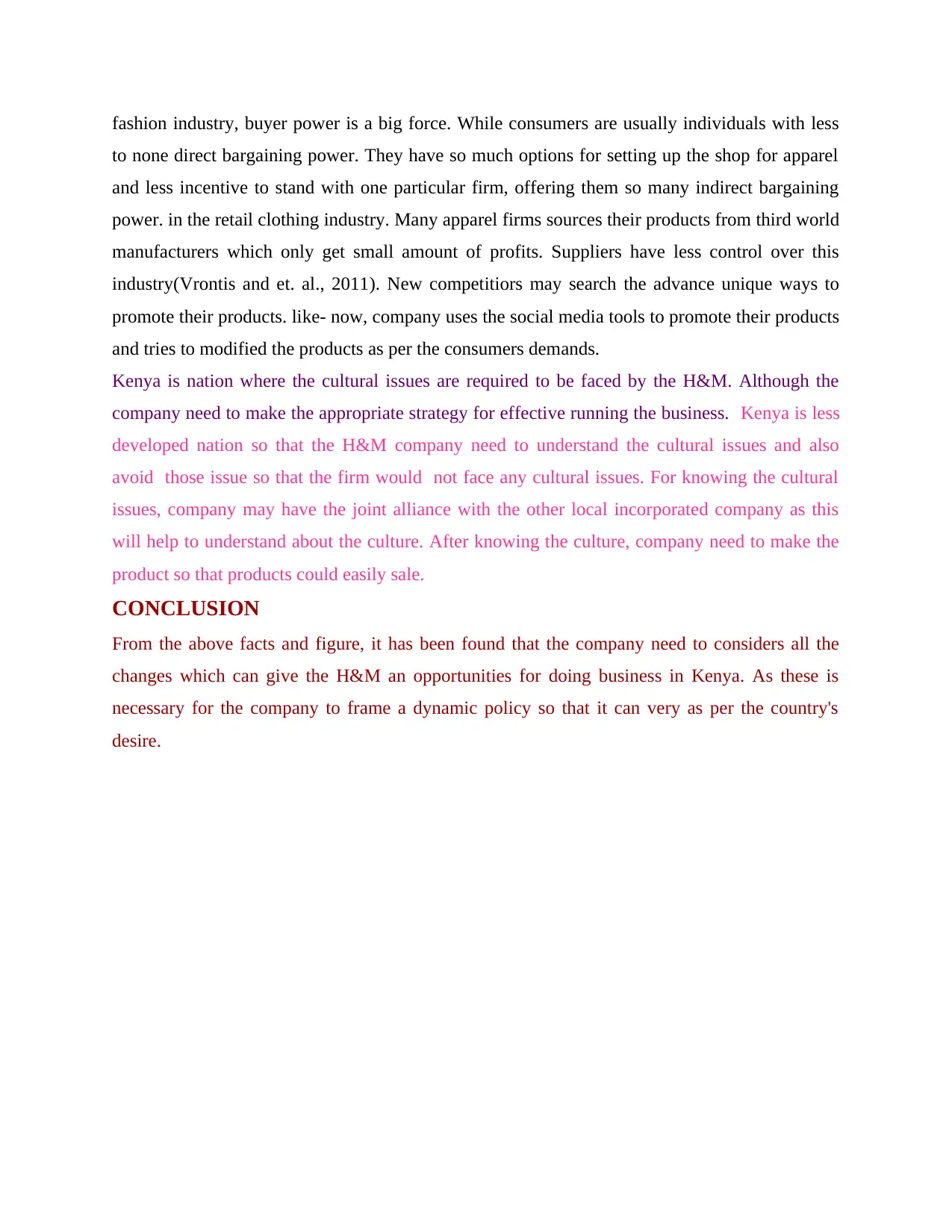
fashion industry, buyer power is a big force. While consumers are usually individuals with less
to none direct bargaining power. They have so much options for setting up the shop for apparel
and less incentive to stand with one particular firm, offering them so many indirect bargaining
power. in the retail clothing industry. Many apparel firms sources their products from third world
manufacturers which only get small amount of profits. Suppliers have less control over this
industry(Vrontis and et. al., 2011). New competitiors may search the advance unique ways to
promote their products. like- now, company uses the social media tools to promote their products
and tries to modified the products as per the consumers demands.
Kenya is nation where the cultural issues are required to be faced by the H&M. Although the
company need to make the appropriate strategy for effective running the business. Kenya is less
developed nation so that the H&M company need to understand the cultural issues and also
avoid those issue so that the firm would not face any cultural issues. For knowing the cultural
issues, company may have the joint alliance with the other local incorporated company as this
will help to understand about the culture. After knowing the culture, company need to make the
product so that products could easily sale.
CONCLUSION
From the above facts and figure, it has been found that the company need to considers all the
changes which can give the H&M an opportunities for doing business in Kenya. As these is
necessary for the company to frame a dynamic policy so that it can very as per the country's
desire.
to none direct bargaining power. They have so much options for setting up the shop for apparel
and less incentive to stand with one particular firm, offering them so many indirect bargaining
power. in the retail clothing industry. Many apparel firms sources their products from third world
manufacturers which only get small amount of profits. Suppliers have less control over this
industry(Vrontis and et. al., 2011). New competitiors may search the advance unique ways to
promote their products. like- now, company uses the social media tools to promote their products
and tries to modified the products as per the consumers demands.
Kenya is nation where the cultural issues are required to be faced by the H&M. Although the
company need to make the appropriate strategy for effective running the business. Kenya is less
developed nation so that the H&M company need to understand the cultural issues and also
avoid those issue so that the firm would not face any cultural issues. For knowing the cultural
issues, company may have the joint alliance with the other local incorporated company as this
will help to understand about the culture. After knowing the culture, company need to make the
product so that products could easily sale.
CONCLUSION
From the above facts and figure, it has been found that the company need to considers all the
changes which can give the H&M an opportunities for doing business in Kenya. As these is
necessary for the company to frame a dynamic policy so that it can very as per the country's
desire.
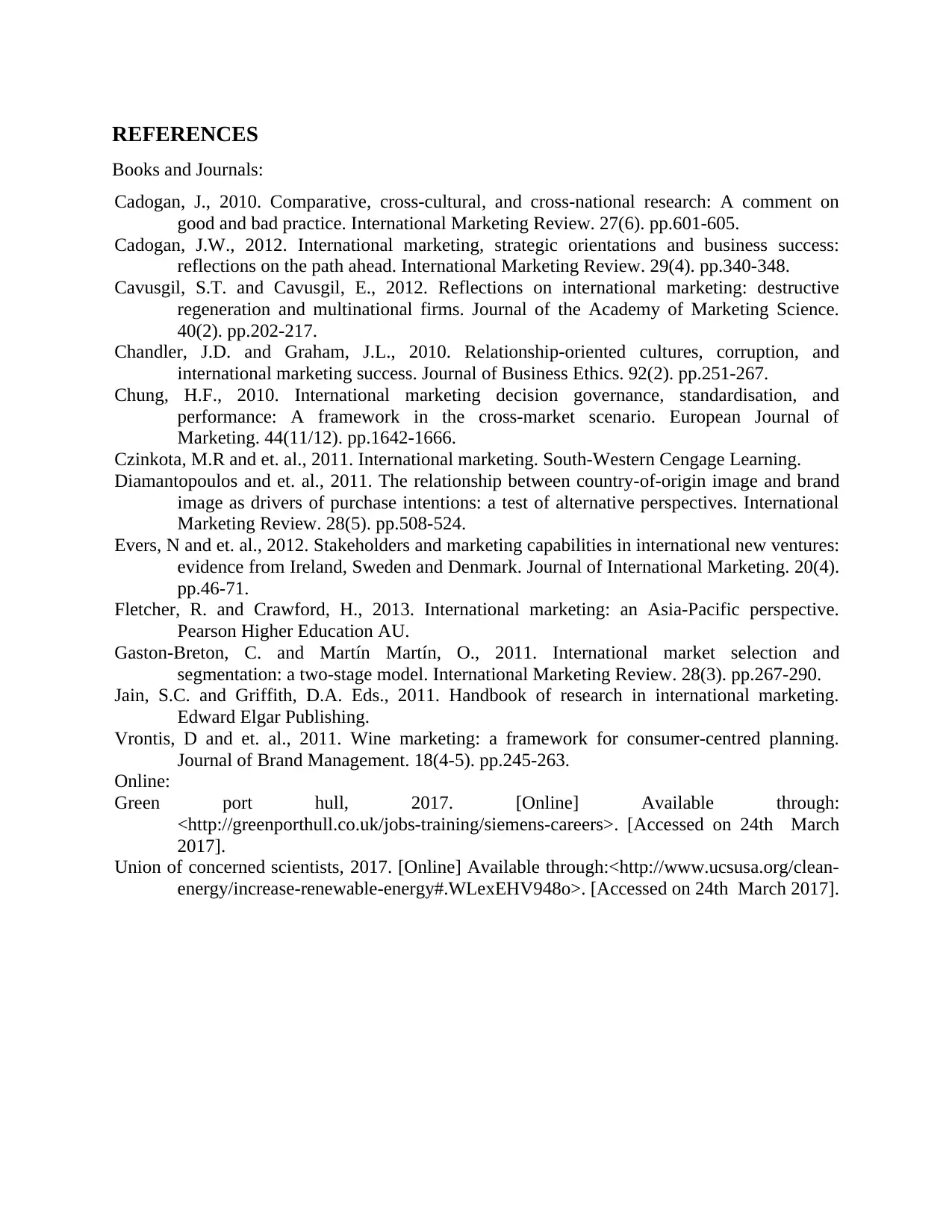
REFERENCES
Books and Journals:
Cadogan, J., 2010. Comparative, cross-cultural, and cross-national research: A comment on
good and bad practice. International Marketing Review. 27(6). pp.601-605.
Cadogan, J.W., 2012. International marketing, strategic orientations and business success:
reflections on the path ahead. International Marketing Review. 29(4). pp.340-348.
Cavusgil, S.T. and Cavusgil, E., 2012. Reflections on international marketing: destructive
regeneration and multinational firms. Journal of the Academy of Marketing Science.
40(2). pp.202-217.
Chandler, J.D. and Graham, J.L., 2010. Relationship-oriented cultures, corruption, and
international marketing success. Journal of Business Ethics. 92(2). pp.251-267.
Chung, H.F., 2010. International marketing decision governance, standardisation, and
performance: A framework in the cross-market scenario. European Journal of
Marketing. 44(11/12). pp.1642-1666.
Czinkota, M.R and et. al., 2011. International marketing. South-Western Cengage Learning.
Diamantopoulos and et. al., 2011. The relationship between country-of-origin image and brand
image as drivers of purchase intentions: a test of alternative perspectives. International
Marketing Review. 28(5). pp.508-524.
Evers, N and et. al., 2012. Stakeholders and marketing capabilities in international new ventures:
evidence from Ireland, Sweden and Denmark. Journal of International Marketing. 20(4).
pp.46-71.
Fletcher, R. and Crawford, H., 2013. International marketing: an Asia-Pacific perspective.
Pearson Higher Education AU.
Gaston-Breton, C. and Martín Martín, O., 2011. International market selection and
segmentation: a two-stage model. International Marketing Review. 28(3). pp.267-290.
Jain, S.C. and Griffith, D.A. Eds., 2011. Handbook of research in international marketing.
Edward Elgar Publishing.
Vrontis, D and et. al., 2011. Wine marketing: a framework for consumer-centred planning.
Journal of Brand Management. 18(4-5). pp.245-263.
Online:
Green port hull, 2017. [Online] Available through:
<http://greenporthull.co.uk/jobs-training/siemens-careers>. [Accessed on 24th March
2017].
Union of concerned scientists, 2017. [Online] Available through:<http://www.ucsusa.org/clean-
energy/increase-renewable-energy#.WLexEHV948o>. [Accessed on 24th March 2017].
Books and Journals:
Cadogan, J., 2010. Comparative, cross-cultural, and cross-national research: A comment on
good and bad practice. International Marketing Review. 27(6). pp.601-605.
Cadogan, J.W., 2012. International marketing, strategic orientations and business success:
reflections on the path ahead. International Marketing Review. 29(4). pp.340-348.
Cavusgil, S.T. and Cavusgil, E., 2012. Reflections on international marketing: destructive
regeneration and multinational firms. Journal of the Academy of Marketing Science.
40(2). pp.202-217.
Chandler, J.D. and Graham, J.L., 2010. Relationship-oriented cultures, corruption, and
international marketing success. Journal of Business Ethics. 92(2). pp.251-267.
Chung, H.F., 2010. International marketing decision governance, standardisation, and
performance: A framework in the cross-market scenario. European Journal of
Marketing. 44(11/12). pp.1642-1666.
Czinkota, M.R and et. al., 2011. International marketing. South-Western Cengage Learning.
Diamantopoulos and et. al., 2011. The relationship between country-of-origin image and brand
image as drivers of purchase intentions: a test of alternative perspectives. International
Marketing Review. 28(5). pp.508-524.
Evers, N and et. al., 2012. Stakeholders and marketing capabilities in international new ventures:
evidence from Ireland, Sweden and Denmark. Journal of International Marketing. 20(4).
pp.46-71.
Fletcher, R. and Crawford, H., 2013. International marketing: an Asia-Pacific perspective.
Pearson Higher Education AU.
Gaston-Breton, C. and Martín Martín, O., 2011. International market selection and
segmentation: a two-stage model. International Marketing Review. 28(3). pp.267-290.
Jain, S.C. and Griffith, D.A. Eds., 2011. Handbook of research in international marketing.
Edward Elgar Publishing.
Vrontis, D and et. al., 2011. Wine marketing: a framework for consumer-centred planning.
Journal of Brand Management. 18(4-5). pp.245-263.
Online:
Green port hull, 2017. [Online] Available through:
<http://greenporthull.co.uk/jobs-training/siemens-careers>. [Accessed on 24th March
2017].
Union of concerned scientists, 2017. [Online] Available through:<http://www.ucsusa.org/clean-
energy/increase-renewable-energy#.WLexEHV948o>. [Accessed on 24th March 2017].
1 out of 9
Related Documents
Your All-in-One AI-Powered Toolkit for Academic Success.
+13062052269
info@desklib.com
Available 24*7 on WhatsApp / Email
![[object Object]](/_next/static/media/star-bottom.7253800d.svg)
Unlock your academic potential
© 2024 | Zucol Services PVT LTD | All rights reserved.





